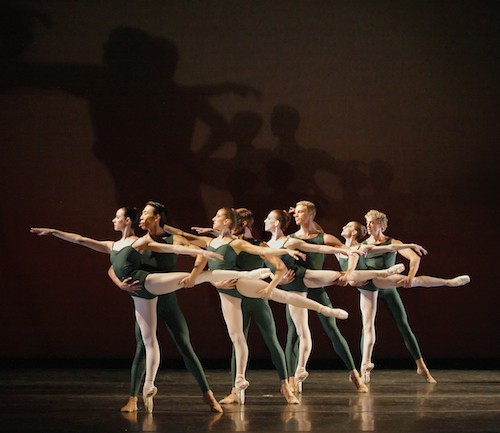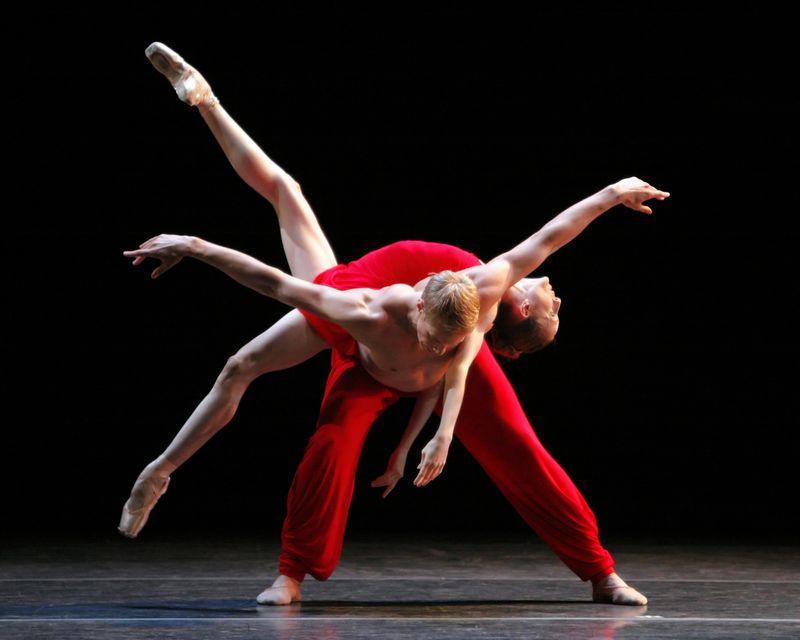In the Ballets Russes centenary year it’s worth remembering that the iconic Diaghilev ballets were only the few lasting landmarks in a sea of constant novelties and shipwrecks. So if Christopher Wheeldon doesn’t take many great reviews back to the States after Morphoses’ third visit to London, he should be roundly applauded for being so generous to fellow-choreographers and mounting this enterprise in stark times that need initiative more than ever. But if only he’d married the first programme's Ratmansky Boléro to his own two in the second programme and got rid of the dross.
Continuum, his second work to Gyorgy Ligeti’s piano music after his famously fine Polyphonia, is just as magnificent, another ballet from the dark, astringent side of his talent which shouts what a master dancemaker Wheeldon can be. The music refuses to ingratiate - the notes spill out of the two pianos in haphazard dissonances, or sound long, mysterious chords - while the choreography’s superb command of pose, manipulative ingenuity and damn-your-eyes stillness demonstrates that only someone with a strong thought to utter can afford to speak it deliberately.
 Continuum is remarkable for its bold and unhurried curiosity about the iconic male-female balancing act. There are shades of Balanchine’s Agon in its almost physiotherapeutic pas de deux, some grippingly slow promenades where the man parades the woman in fascinating ways. In one strange sequence, the man crawls on all fours around the woman’s feet while she leans on him in a deep penché, a laconic, inviolable goddess in a mystical aesthetic realm.
Continuum is remarkable for its bold and unhurried curiosity about the iconic male-female balancing act. There are shades of Balanchine’s Agon in its almost physiotherapeutic pas de deux, some grippingly slow promenades where the man parades the woman in fascinating ways. In one strange sequence, the man crawls on all fours around the woman’s feet while she leans on him in a deep penché, a laconic, inviolable goddess in a mystical aesthetic realm.
Witty asides release the pressure: a Bach-like fugue decorated by unexpectedly elegant upside-down floor rolls for the girls clutching their pointed feet; a bravura sort of Russian drinking dance for four men with linked arms.
And there is the Whelan moment - as almost always in Wheeldon’s ballets - the supremely theatrical moment when out of the darkness a light beams down on the Easter Island face of the great New York ballerina Wendy Whelan, with her skeletal body and extraordinary liquidity of movement, and a pas de deux will start that makes everything else that has gone before, no matter how intricate, appear the till-ready for the main event.
Though her back now appears to be stiffening after 20 years of dancing, she generated here something phenomenal on stage, a forbidding impassivity, a sort of ice-burn. The Whelan-Wheeldon combination is the most significant muse-choreographer relationship I’ve seen, and though this work was originally made for San Francisco Ballet, with Whelan in the role it has acquired its icon.
After such superior stuff, the Lightfoot-Leon duet, Softly As I Leave You, looked even more grandiloquent than it did on the opening programme, and yet you could see a link (not too welcome) from it to Wheeldon’s new creation, Rhapsody Fantaisie, which had its world premiere here.
Even with a musical choreographer, it can’t be a given that you will hear music the way he does. I know I’m way off Wheeldon’s wavelength with Michael Nyman (see his DGV for the Royal Ballet) and here too with Rachmaninov’s meaty, mega-watt Suites for two pianos, whose proliferation of notes and textures at some length is the diagonal opposite to the sparse pointedness of the Ligeti in Continuum.
The mismatch between flamboyance and feyness continues in the choreography
Wheeldon is surely pursuing a development here, trying to deepen the emotional liberation in his choreography, but for my money is setting off in the wrong direction. The dancers are dressed in neon-scarlet jersey, disastrously, with some fey cocktail-bar light-drawings projected over them. The mismatch between flamboyance and feyness continues in the choreography which looks as if Wheeldon is trying on the Dutch approach for size, with busy gesture and too-slick, generalised ballet class enchaînements.
I can see why he couldn’t do his angular neo-classical thing with such big-R Romantic music, but I'm fogged by his resort to that Euro-cliché where men and women make a love dance of animal nuzzles and head-butts, like gambolling goats, rather than the human touches and glances that demand true adult expressiveness.
There are some characteristically good impressions, such a thoughtful sequence of female solos over a long-drawn-out waltz, a properly romantic duet for Whelan with Matthew Prescott and the striking leg swings for the Easter Bells of the opening and closing piece. The audience was in raptures, though I'd hope two-thirds must have been for Rachmaninov’s infectious music and the spiffing playing by the pianists Jonathan Higgins and Cameron Grant.
- Morphoses website here. The company performs in New York next Thurs-Sun, book here; then in Amsterdam's Het Muziektheater 12, 14 & 15 November, book here
- Christopher Wheeldon's Garland Dance is part of the Royal Ballet's production of The Sleeping Beauty, currently in repertoire.
- Check out what's on at Sadler's Wells this season














Add comment